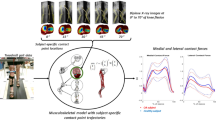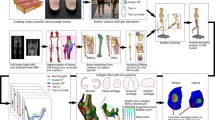Abstract
One of the main causes that make knee osteoarthritis (OA) worse is load concentration at the medial compartment of knee cartilage. It is alternatively measured by employing knee adduction moment (KAM). Since toe-in gait decreases the 1st peak of KAM, it has been considered as a non-surgical prevention of OA progressing. However, direct measures such as contact pressure at knee cartilage in motion have not been available so far. Obtaining contact pressure at knee cartilage by FE analysis is difficult because exact muscle forces are not available and because FE model should be reconstructed at every stance phase. To obtain contact pressure at knee cartilage during gait, a method employing FE analysis based on motion analysis has been used in this study. Reference FE model of lower extremities was constructed and transformed to specific stance phases of gait. Ground reaction forces and muscle forces from motion analysis were employed as loading conditions. Finally, contact pressure distributions on knee cartilage at 1st peak, mid stance, 2nd peak could be obtained with respect to foot progression angle. The result shows that toe-in gait could be effective for knee OA patients by dispersing contact pressure concentrated in medial knee compartment to lateral part.
Similar content being viewed by others
References
Ahlbäck, S., Bauer, G. C., and Bohne, W. H., “Spontaneous Osteonecrosis of the Knee,” Arthritis & Rheumatology, vol. 11, no. 6, pp. 705–733, 1968.
Schipplein, O. D. and Andriacchi, T. P., “Interaction between Active and Passive Knee Stabilizers during Level Walking,” Journal of Orthopaedic Research, vol. 9, no. 1, pp. 113–119, 1991.
Hunt, M. A., Birmingham, T. B., Giffin, J. R., and Jenkyn, T. R., “Associations among Knee Adduction Moment, Frontal Plane Ground Reaction Force, and Lever Arm during Walking in Patients with Knee Osteoarthritis,” Journal of Biomechanics, vol. 39, no. 12, pp. 2213–2220, 2006.
Guo, M., Axe, M. J., and Manal, K., “The Influence of Foot Progression Angle on the Knee Adduction Moment during Walking and Stair Climbing in Pain Free Individuals with Knee Osteoarthritis,” Gait & Posture, vol. 26, no. 3, pp. 436–441, 2007.
Jenkyn, T. R., Hunt, M. A., Jones, I. C., Giffin, J. R., and Birmingham, T. B., “Toe-Out Gait in Patients with Knee Osteoarthritis Partially Transforms External Knee Adduction Moment into Flexion Moment during Early Stance Phase of Gait: A Tri-Planar Kinetic Mechanism,” Journal of Biomechanics, vol. 41, no. 2, pp. 276–283, 2008.
Zhao, D., Banks, S. A., Mitchell, K. H., D'Lima, D. D., Colwell, C. W., and Fregly, B. J., “Correlation between the Knee Adduction Torque and Medial Contact Force for a Variety of Gait Patterns,” Journal of Orthopaedic Research, vol. 25, no. 6, pp. 789–797, 2007.
Miyazaki, T., Wada, M., Kawahara, H., Sato, M., Baba, H., and Shimada, S., “Dynamic Load at Baseline Can Predict Radiographic Disease Progression in Medial Compartment Knee Osteoarthritis,” Annals of the Rheumatic Diseases, vol. 61, no. 7, pp. 617–622, 2002.
Shull, P. B., Shultz, R., Silder, A., Dragoo, J. L., Besier, T. F., et al., “Toe-in Gait Reduces the First Peak Knee Adduction Moment in Patients with Medial Compartment Knee Osteoarthritis,” Journal of Biomechanics, vol. 46, no. 1, pp. 122–128, 2013.
Simic, M., Wrigley, T., Hinman, R., Hunt, M., and Bennell, K., “Altering Foot Progression Angle in People with Medial Knee Osteoarthritis: The Effects of Varying Toe-in and Toe-out Angles are Mediated by Pain and Malalignment,” Osteoarthritis and cartilage, vol. 21, no. 9, pp. 1272–1280, 2013.
Jung, Y., Koo, Y.-J., and Koo, S., “Simultaneous Estimation of Ground Reaction Force and Knee Contact Force during Walking and Squatting,” International Journal of Precision Engineering and Manufacturing, vol. 18, no. 9, pp. 1263–1268, 2017.
Purevsuren, T., Kim, K., Nha, K.W., and Kim, Y. H., “Evaluation of Compressive and Shear Joint Forces on Medial and Lateral Compartments in Knee Joint during Walking Before and after Medial Open-Wedge High Tibial Osteotomy,” International Journal of Precision Engineering and Manufacturing, vol. 17, no. 10, pp. 1365–1370, 2016.
Shin, S. H., Seo, S. B., Yu, M., Jeong, H. C., Cho, K. S., et al., “Muscle Activity Analysis of Lower Limb Training for Early Rehabilitation Cycling System in Supine Position,” Journal of the Korean Society for Precision Enngineering, vol. 33, no. 9, pp. 753–760, 2016.
Seo, H., Jung, H., Jung, D., and Lim, D., “Characteristics of Ankle Strategy Responses to Dynamic Tilting Perturbations,” Journal of the Korean Society for Precision Engineering, vol. 35, no. 2, pp. 203–210, 2018.
Ko, C.-Y., Ko, J., Kim, H. J., and Lim, D., “New Wearable Exoskeleton for Gait Rehabilitation Assistance Integrated with Mobility System,” International Journal of Precision Engineering and Manufacturing, vol. 17, no. 7, pp. 957–964, 2016.
Rutherford, D. J., Hubley-Kozey, C. L., Deluzio, K. J., Stanish, W. D., and Dunbar, M., “Foot Progression Angle and the Knee Adduction Moment: A Cross-Sectional Investigation in Knee Osteoarthritis,” Osteoarthritis and Cartilage, vol. 16, no. 8, pp. 883–889, 2008.
Bencke, J., Christiansen, D., Jensen, K., Okholm, A., Sonne-Holm, S., and Bandholm, T., “Measuring Medial Longitudinal Arch Deformation during Gait. A Reliability Study,” Gait & Posture, vol. 35, no. 3, pp. 400–404, 2012.
Chen, G., Li, X.-C., Wu, G.-Q., Zhang, S.-X., **ong, X.-F., et al., “Three-Dimensional Reconstruction of Digitized Human Liver: Based on Chinese Visible Human,” Chinese Medical Journal, vol. 123, no. 2, pp. 146–150, 2010.
Yasuda, K., van Eck, C. F., Hoshino, Y., Fu, F. H., and Tashman, S., “Anatomic Single-and Double-Bundle Anterior Cruciate Ligament Reconstruction, Part 1: Basic Science,” The American Journal of Sports Medicine, vol. 39, no. 8, pp. 1789–1800, 2011.
Claes, S., Vereecke, E., Maes, M., Victor, J., Verdonk, P., and Bellemans, J., “Anatomy of the Anterolateral Ligament of the Knee,” Journal of Anatomy, vol. 223, no. 4, pp. 321–328, 2013.
Kiapour, A., Kiapour, A. M., Kaul, V., Quatman, C. E., Wordeman, S. C., et al., “Finite Element Model of the Knee for Investigation of Injury Mechanisms: Development and Validation,” Journal of Biomechanical Engineering, Vol. 136, No. 1, Paper No. 011002, 2014.
Attarian, D. E., McCrackin, H. J., DeVito, D. P., McElhaney, J. H., and Garrett Jr, W. E., “Biomechanical Characteristics of Human Ankle Ligaments,” Foot & Ankle, vol. 6, no. 2, pp. 54–58, 1985.
Siegler, S., Block, J., and Schneck, C. D., “The Mechanical Characteristics of the Collateral Ligaments of the Human Ankle Joint,” Foot & Ankle, vol. 8, no. 5, pp. 234–242, 1988.
Corazza, F., O’connor, J., Leardini, A., and Castelli, V. P., “Ligament Fibre Recruitment and Forces for the Anterior Drawer Test at the Human Ankle Joint,” Journal of Biomechanics, vol. 36, no. 3, pp. 363–372, 2003.
Butler, D. L., Kay, M. D., and Stouffer, D. C., “Comparison of Material Properties in Fascicle-Bone Units from Human Patellar Tendon and Knee Ligaments,” Journal of Biomechanics, vol. 19, no. 6, pp. 425–432, 1986.
Quapp, K. and Weiss, J., “Material Characterization of Human Medial Collateral Ligament,” Journal of Biomechanical Engineering, vol. 120, no. 6, pp. 757–763, 1998.
Shirazi, R., Shirazi-Adl, A., and Hurtig, M., “Role of Cartilage Collagen Fibrils Networks in Knee Joint Biomechanics under Compression,” Journal of Biomechanics, vol. 41, no. 16, pp. 3340–3348, 2008.
Fukubayashi, T. and Kurosawa, H., “The Contact Area and Pressure Distribution Pattern of the Knee: A Study of Normal and Osteoarthrotic Knee joints,” Acta Orthopaedica Scandinavica, vol. 51, Nos. 1–6, pp. 871–879, 1980.
Kurosawa, H., Fukubayashi, T., and Nakajima, H., “Load-Bearing Mode of the Knee Joint: Physical Behavior of the Knee Joint with or without Menisci,” Clinical Orthopaedics and Related Research, no. 149, pp. 283–290, 1980.
Krause, W. R., Pope, M. H., Johnson, R. J., and Wilder, D. G., “Mechanical Changes in the Knee after Meniscectomy,” The Journal of Bone and Joint Surgery. American Volume, vol. 58, no. 5, pp. 599–604, 1976.
Walker, P. S. and Erkman, M. J., “The Role of the Menisci in Force Transmission Across the Knee,” Clinical Orthopaedics and Related Research, no. 109, pp. 184–192, 1975.
Inaba, H. I., Arai, M. A., and Watanabe, W. W., “Influence of the Varus-Valgus Instability on the Contact of the Femoro-Tibial Joint,” Proceedings of the Institution of Mechanical Engineers, Part H: Journal of Engineering in Medicine, vol. 204, no. 1, pp. 61–64, 1990.
Anderson, D. D., Goldsworthy, J. K., Li, W., Rudert, M. J., Tochigi, Y., and Brown, T. D., “Physical Validation of a Patient-Specific Contact Finite Element Model of the Ankle,” Journal of Biomechanics, vol. 40, no. 8, pp. 1662–1669, 2007.
Park, S., Shim, J., Yoon, J. R., and Chae, S.-W., “Assessment of Stresses at the Lower Extremity Joints Wearing Laterally Wedged Insoles,” International Journal of Precision Engineering and Manufacturing, vol. 18, no. 3, pp. 325–331, 2017.
Hurwitz, D. E., Ryals, A. B., Case, J. P., Block, J. A., and Andriacchi, T. P., “The Knee Adduction Moment during Gait in Subjects with Knee Osteoarthritis is More Closely Correlated with Static Alignment than Radiographic Disease Severity, Toe out Angle and Pain,” Journal of Orthopaedic Research, vol. 20, no. 1, pp. 101–107, 2002.
Author information
Authors and Affiliations
Corresponding author
Rights and permissions
About this article
Cite this article
Yoon, J., Ha, S., Lee, S. et al. Analysis of Contact Pressure at Knee Cartilage during Gait with Respect to Foot Progression Angle. Int. J. Precis. Eng. Manuf. 19, 761–766 (2018). https://doi.org/10.1007/s12541-018-0091-2
Received:
Revised:
Accepted:
Published:
Issue Date:
DOI: https://doi.org/10.1007/s12541-018-0091-2




